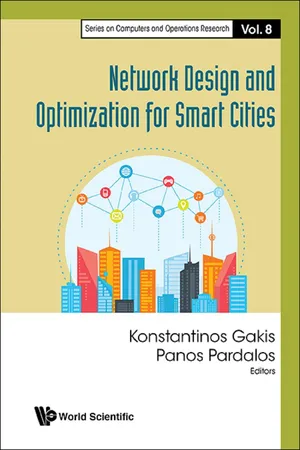
- 404 pages
- English
- ePUB (mobile friendly)
- Available on iOS & Android
Network Design And Optimization For Smart Cities
About This Book
-->
This comprehensive reference text is a collection of important research findings on the latest developments in network modeling for optimization of smart cities. Such models can be used from outlining the fundamental concepts of urban development to the description and optimization of physical networks, such as power, water or telecommunications. Networks help us understand city economics and various aspects of human interactions within cities with particular applications in quality of life and the flow of people and goods. Finally, the natural environment and even the climate of cities can be modeled and managed as networks.
--> Contents:
- A Mathematical Programing Model for Regional Planning Incorporating Economics, Logistics, Infrastructure and Land Use (Jesús Velásquez, Carolina Saldaña and Edgar Gutierrez-Franco)
- Energy Efficiency in Urban Electrical Grids through Consumer Networking (Georgios T Andreou, Aggelos S Bouhouras, Apostolos N Milioudis and Dimitris P Labridis)
- Public Location Monitoring Based on Open Source Hardware and Software (Riccardo Beltramo and Paolo Cantore)
- Congestion and Traffic Management at Urban Networks: State-of the-Art Approaches and Challenges (Alexandra Kondyli)
- Transport Solutions and Social Networking for Elderly People in a Smart City Environment (E Stylianidis, E Valari, K Smagas and V Giannoglou)
- Navigating the Internet of Things (Stamatina Th Rassia and Henriette Steiner)
- From Managing Urban Freight to Smart City Logistics Networks (Tolga Bektaş, Teodor Gabriel Crainic and Tom Van Woensel)
- Simulation-based Assessments of Smart Mobility Strategies (Hussein Dia, Farid Javanshour and Sakda Panwai)
- Smart Sensing — New Approaches for User Driven Social Urban Acting (Jan-Philipp Exner and Peter Zeile)
- Reality Mining in Urban Spaces by Using Citizens as Living Sensors (Dimitrios Ververidis, Spiros Nikolopoulos, Symeon Papadopoulos and Ioannis Kompatsiaris)
- Climate Change-Oriented Urban Green Network Design: A Decision Support Tool (Carmela Gargiulo, Andrea Tulisi and Floriana Zucaro)
- City of Things: A Multidisciplinary Smart Cities Testbed for IoT, Big Data and Living Labs Innovation (Bart Braem, Steven Latré, Philip Leroux, Piet Demeester, Tanguy Coenen and Pieter Ballon)
- A City Full of Knowledge: Objects, Habitats, Symbols (Andrea Cerroni)
- Urban Flows and Big Data (Daniel Sarasa Funes)
- Building an Urban Big Data Sharing System (Daniel Sarasa Funes)
- Smart City Policies and Practices for Istanbul in a Nutshell (Ulas Akin and Aybike Ongel)
--> -->
Readership: Urban planners, researchers, academics, professionals and graduate students in neural networks/networking, systems engineering, electrical & electronic engineering, and energy studies.
-->Smart Cities;Networks;E-Governance;Optimization;Urban Planning0
Frequently asked questions
Information
Table of contents
- Cover
- Title
- Copyright
- Preface
- Contents
- Chapter 1. A Mathematical Programing Model for Regional Planning Incorporating Economics, Logistics, Infrastructure and Land Use
- Chapter 2. Energy Efficiency in Urban Electrical Grids through Consumer Networking
- Chapter 3. Public Location Monitoring Based on Open Source Hardware and Software
- Chapter 4. Congestion and Traffic Management at Urban Networks: State-of the-Art Approaches and Challenges
- Chapter 5. Transport Solutions and Social Networking for Elderly People in a Smart City Environment
- Chapter 6. Navigating the Internet of Things
- Chapter 7. From Managing Urban Freight to Smart City Logistics Networks
- Chapter 8. Simulation-based Assessments of Smart Mobility Strategies
- Chapter 9. Smart Sensing – New Approaches for User Driven Social Urban Acting
- Chapter 10. Reality Mining in Urban Spaces by Using Citizens as Living Sensors
- Chapter 11. Climate Change-Oriented Urban Green Network Design: A Decision Support Tool
- Chapter 12. City of Things: A Multidisciplinary Smart Cities Testbed for IoT, Big Data and Living Labs Innovation
- Chapter 13. A City Full of Knowledge: Objects, Habitats, Symbols
- Chapter 14. Urban Flows and Big Data
- Chapter 15. Building an Urban Big Data Sharing System
- Chapter 16. Smart City Policies and Practices for Istanbul in a Nutshell
- Index